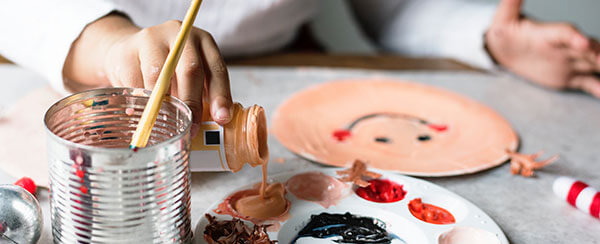The Importance Of Art As A Lifelong Skill
Pablo Picasso once famously said: “Every child is an artist. The problem is how to remain an artist once we grow up.” In fact, many famous artists began demonstrating their talent at an early age. Salvador Dalí completed what is thought to be one of his first paintings, Landscape Near Figueras, between the ages of 6 and 10. And Michelangelo painted the impressive The Torment of Saint Anthony at the age of 12 or 13.
Clearly, when it comes to art, age is just a number. Encouraging young children to explore their artistic creativity can be incredibly beneficial, giving them a sense of accomplishment and helping them develop lifelong skills that will be useful regardless of what path they choose in life.
Exercise their creative muscles
When children are given paint and paper, it isn’t just a means of keeping them occupied for a while. Throughout the school day they are required to work on subjects that are mostly clear and exact in nature. Mathematical problems always have a singular answer and a correct way to arrive at it. Spelling is either correct or it isn’t. The plot of a story they’re assigned to read is set in stone. But art has no limitations and allows children to truly express themselves and – quite literally – draw outside of the lines. They can be as creative as their imagination drives them to be, and it’s important to encourage that. So much of education is black and white – art allows children to explore a full and vibrant palate through painting and drawing, and they can do what they please.
Insights into how they see the world
Giving children the freedom to freely create art as ideas flow from their mind through their fingers and onto paper is an excellent way to get a glimpse of how they see the world and what is going on in their lives. Do you notice any recurring themes among their drawings? Do their paintings make heavy use of certain colors over others? Paying attention to the subjects of their art will reveal what is important to them, what fears they might have, what makes them happy and even how they feel about life at school and at home. You can then take that and have a discussion with them. Their world is much bigger to them than you might imagine, and their art can help you see what that looks like.
Art can affect a child’s overall academic performance
A study conducted by Americans for the Arts found that children who participate in the arts on a regular basis are more likely to excel in academic achievement – in all areas of their education. This is because art aids in language development (through discussing their “works” and also taking the words they know and transforming them into images) as well as inventiveness and visual learning. What may look like scribbles or a messy finger painting disaster can actually help guide your children toward academic success, both now and in the future. And at the Australian International School in Singapore, we encourage students to be as creative as possible.
Learning skills that will last a lifetime
The skills a child learns through art can last a lifetime and guide them toward academic achievement, personal growth and improved communication skills. Art can foster their creativity and help them discover and refine talents they didn’t know they had. They can take pride in the work that they produce – what child doesn’t immediately smile when a parent hangs his or her drawing on the refrigerator? Art can also teach children the importance of perseverance. If they aren’t happy with what they are painting or drawing, they can learn to keep trying to make it just the way they want it or start from scratch to get it “just right”, similar to how everyone must learn to adapt to various situations throughout life.
With the STEM (science, technology, engineering and mathematics) subjects becoming increasingly important – and with good cause – it’s important to also understand the role of creative art in a child’s education. After all, what would an architect or engineer be without an eye for design?
And of course, don’t forget to save their little “masterpieces” – they’re certain to be some of your most valuable and nostalgic possessions one day.






